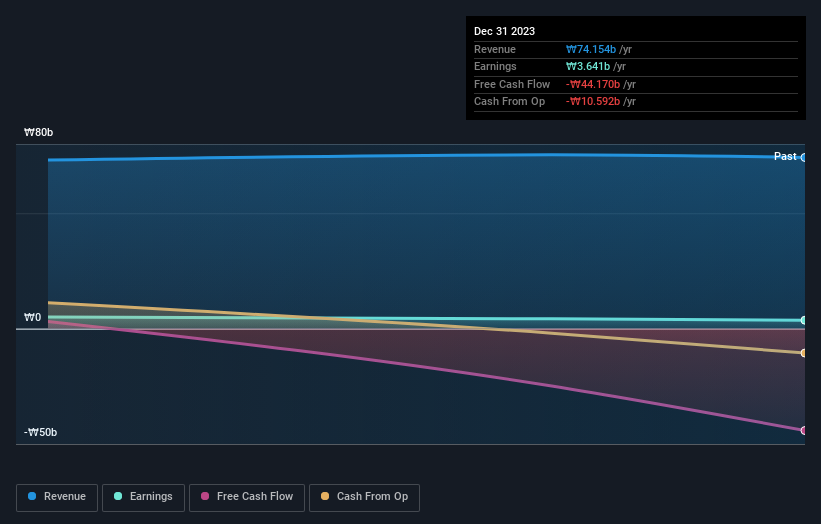Stock Analysis
- South Korea
- /
- Semiconductors
- /
- KOSDAQ:A445090
ASICLAND Co., Ltd.'s (KOSDAQ:445090) last week's 14% decline must have disappointed individual investors who have a significant stake

Key Insights
- ASICLAND's significant individual investors ownership suggests that the key decisions are influenced by shareholders from the larger public
- 46% of the business is held by the top 25 shareholders
- Insider ownership in ASICLAND is 44%
A look at the shareholders of ASICLAND Co., Ltd. (KOSDAQ:445090) can tell us which group is most powerful. And the group that holds the biggest piece of the pie are individual investors with 54% ownership. In other words, the group stands to gain the most (or lose the most) from their investment into the company.
While the holdings of individual investors took a hit after last week’s 14% price drop, insiders with their 44% also suffered.
Let's take a closer look to see what the different types of shareholders can tell us about ASICLAND.
View our latest analysis for ASICLAND

What Does The Lack Of Institutional Ownership Tell Us About ASICLAND?
Institutional investors often avoid companies that are too small, too illiquid or too risky for their tastes. But it's unusual to see larger companies without any institutional investors.
There are multiple explanations for why institutions don't own a stock. The most common is that the company is too small relative to funds under management, so the institution does not bother to look closely at the company. It is also possible that fund managers don't own the stock because they aren't convinced it will perform well. ASICLAND might not have the sort of past performance institutions are looking for, or perhaps they simply have not studied the business closely.

ASICLAND is not owned by hedge funds. Jongmin Lee is currently the company's largest shareholder with 26% of shares outstanding. For context, the second largest shareholder holds about 9.1% of the shares outstanding, followed by an ownership of 4.1% by the third-largest shareholder.
Our studies suggest that the top 25 shareholders collectively control less than half of the company's shares, meaning that the company's shares are widely disseminated and there is no dominant shareholder.
While studying institutional ownership for a company can add value to your research, it is also a good practice to research analyst recommendations to get a deeper understand of a stock's expected performance. As far as we can tell there isn't analyst coverage of the company, so it is probably flying under the radar.
Insider Ownership Of ASICLAND
While the precise definition of an insider can be subjective, almost everyone considers board members to be insiders. The company management answer to the board and the latter should represent the interests of shareholders. Notably, sometimes top-level managers are on the board themselves.
I generally consider insider ownership to be a good thing. However, on some occasions it makes it more difficult for other shareholders to hold the board accountable for decisions.
It seems insiders own a significant proportion of ASICLAND Co., Ltd.. Insiders own ₩216b worth of shares in the ₩486b company. We would say this shows alignment with shareholders, but it is worth noting that the company is still quite small; some insiders may have founded the business. You can click here to see if those insiders have been buying or selling.
General Public Ownership
The general public, who are usually individual investors, hold a substantial 54% stake in ASICLAND, suggesting it is a fairly popular stock. With this amount of ownership, retail investors can collectively play a role in decisions that affect shareholder returns, such as dividend policies and the appointment of directors. They can also exercise the power to vote on acquisitions or mergers that may not improve profitability.
Next Steps:
It's always worth thinking about the different groups who own shares in a company. But to understand ASICLAND better, we need to consider many other factors. Case in point: We've spotted 3 warning signs for ASICLAND you should be aware of, and 2 of them don't sit too well with us.
Of course this may not be the best stock to buy. Therefore, you may wish to see our free collection of interesting prospects boasting favorable financials.
NB: Figures in this article are calculated using data from the last twelve months, which refer to the 12-month period ending on the last date of the month the financial statement is dated. This may not be consistent with full year annual report figures.
Valuation is complex, but we're helping make it simple.
Find out whether ASICLAND is potentially over or undervalued by checking out our comprehensive analysis, which includes fair value estimates, risks and warnings, dividends, insider transactions and financial health.
View the Free AnalysisHave feedback on this article? Concerned about the content? Get in touch with us directly. Alternatively, email editorial-team (at) simplywallst.com.
This article by Simply Wall St is general in nature. We provide commentary based on historical data and analyst forecasts only using an unbiased methodology and our articles are not intended to be financial advice. It does not constitute a recommendation to buy or sell any stock, and does not take account of your objectives, or your financial situation. We aim to bring you long-term focused analysis driven by fundamental data. Note that our analysis may not factor in the latest price-sensitive company announcements or qualitative material. Simply Wall St has no position in any stocks mentioned.
About KOSDAQ:A445090
ASICLAND
Operates as an application-specific integrated circuit design solution company in South Korea.
Adequate balance sheet with acceptable track record.

